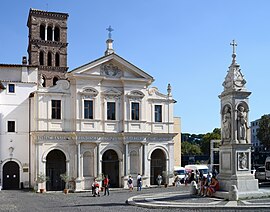| Basilica of St. Bartholomew on the Island | |
|---|---|
| Basilica S. Bartholomaei in Insula | |
Basilica di San Bartolomeo all'Isola | |
 Façade of San Bartolomeo all'Isola on the Tiber Island | |
 Click on the map for a fullscreen view | |
| 41°53′25″N12°28′42″E / 41.89028°N 12.47833°E | |
| Location | Tiber Island, Rome |
| Country | Italy |
| Denomination | Roman Catholic |
| Tradition | Oriental rite |
| Website | www |
| History | |
| Status | Minor basilica, Rectory church, titular church |
| Dedication | Bartholomew the Apostle |
| Consecrated | 10th Century |
| Relics held | Bartholomew the Apostle, Adalbert of Prague, 20th century martyrs |
| Architecture | |
| Architectural type | Church |
| Style | Romanesque, Baroque |
| Completed | 1644 |
| Specifications | |
| Length | 45 metres (148 ft) |
| Width | 22 metres (72 ft) |
| Nave width | 12 metres (39 ft) |
| Administration | |
| District | Lazio |
| Province | Rome |
| Clergy | |
| Cardinal protector | Cardinal Blase Joseph Cupich [1] |
The Basilica of St. Bartholomew on the Island (Italian : Basilica di San Bartolomeo all'Isola, Latin : Basilica S. Bartholomaei in Insula) is a titular minor basilica, located in Rome, Italy. It was founded in 998 by Otto III, Holy Roman Emperor and contains the putative relics of St. Bartholomew the Apostle. [2] It is located on Tiber Island, on the site of the former temple of Aesculapius, which had cleansed the island of its former ill-repute among the Romans and established its reputation as a hospital, continued under Christian auspices today.
Contents
Its cardinal priest has been Cardinal Blase Cupich since 19 November 2016.
